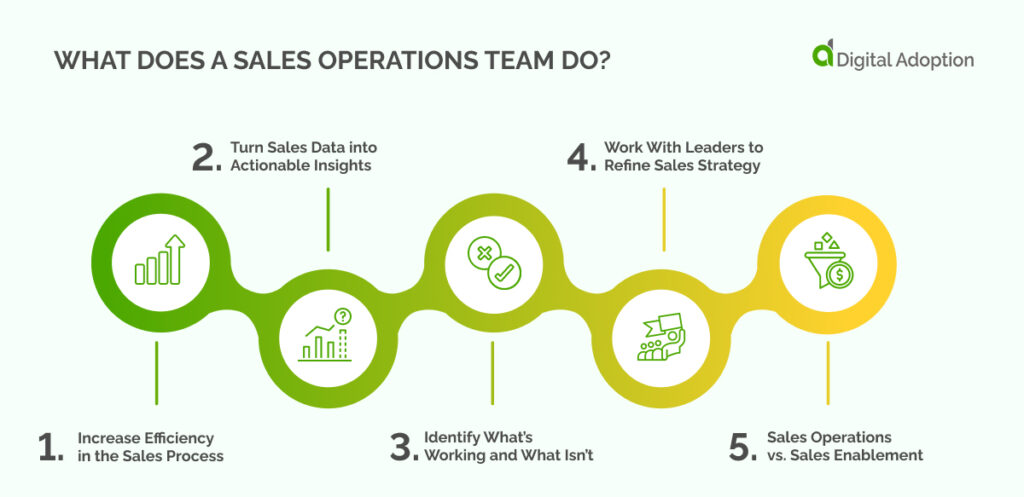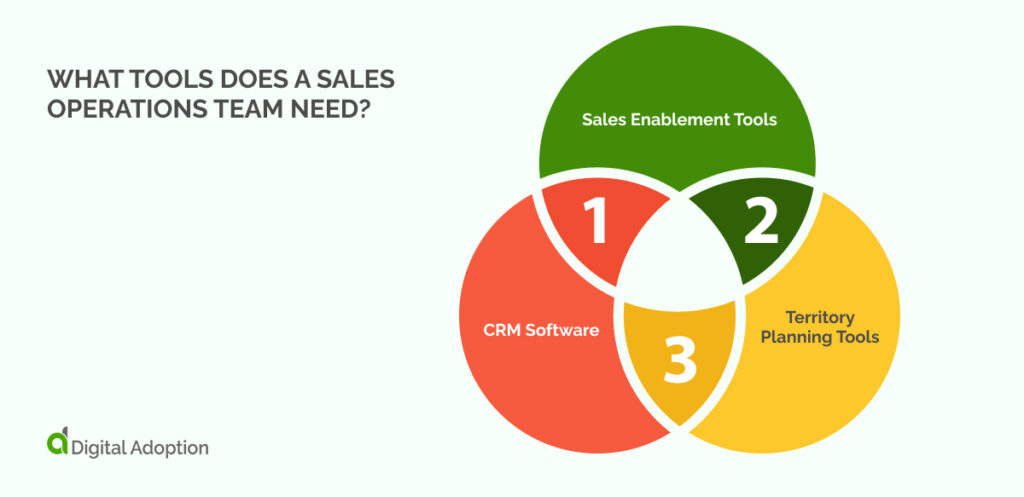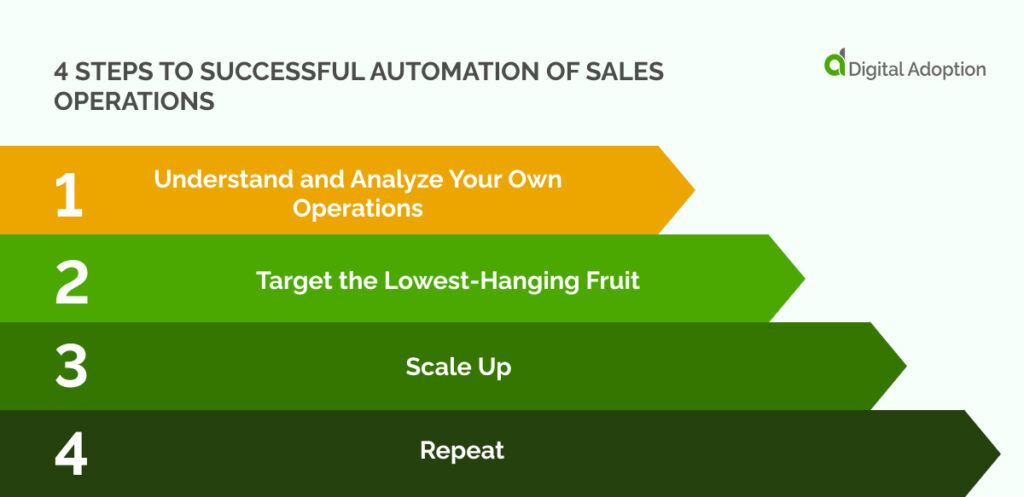Sales Operations isn’t a new business function. Supposedly, the first dedicated Sales Operations team was created by Xerox in the 70’s— that’s half a century ago.
While the core tenets of Sales Operations have stayed the same, the day-to-day of a Sales Operations team looks very different from its “flared jeans and bell sleeves” origins.
Sales Operations have always been about using data and technology to enhance the sales process— and 50 years is a long time in technology lifecycles.
Thankfully, you don’t need to study half a century of history to get the low down on Sales Operations.
This article will take you through the basics, explaining what Sales Operations is, why it’s important, and what a Sales Operations department does.
Then we will explore the intersection of digital transformation and Sales Operations by looking at the cutting-edge technology transforming Sales Operations.
By the end of this article, you’ll be armed with all the knowledge you need to create your own strategic sales roadmap.
- What are Sales Operations?
- Why are Sales Operations Important?
- What Does a Sales Operations Team Do?
- Sales Operations vs. Sales Enablement
- What Tools Does a Sales Operations Team Need?
- How do you Measure the Success of Sales Operations?
- How Sales Operations is Changing
- 4 Steps to Successful Automation of Sales Operations
- Supercharge Your Sales Process with Sales Operations
What are Sales Operations?
Sales Ops is a sales team’s strategic and tactical alignment with the overall company strategy. It involves measuring sales performance, implementing sales process improvements, creating sales process automation tools, and ensuring sales reps have the right information to do their job.
A sales ops team provides data-driven insights to the sales rep and reports to a sales operations manager, helping them to make better decisions about sales operations strategy.
They also create sales process documentation and standard operating procedures for prospecting, lead qualification, sales conversations, closing deals, and more.
In short: A successful sales ops department ensures the sales team runs as efficiently and effectively as possible.
Why are Sales Operations Important?
Sales Operations departments are the backbone of sales success. Ann effective sales ops tea ensures that sales reps are productive, processes are optimized, and sales teams are aligned with the company strategy.
According to McKinsey, assembling a world-class sales team could result in a 20-30% boost in sales productivity.
Efficiency is the name of the game. Salespeople don’t have the time or the skill sets to put in the legwork required to keep up with the competition.
If you consider your sales team the cherry on top, Sales Ops is the rest of the cake.
What Does a Sales Operations Team Do?

What exactly does a Sales ops team do that has such a huge impact on sales?
We touched on this earlier, but let’s take a closer look at the day-to-day of a robust Sales ops team:
Increase Efficiency in the Sales Process.
A Sales Ops team will look at the end-to-end sales process, scouring it for inefficiency or weakness.
They’ll then identify solutions that will save time and money in the sales process and feed them back.
These solutions might be adopting digital tools, rethinking existing processes, or retraining sales .staff.
Turn Sales Data into Actionable Insights
Sales Operations specialists also gather sales data from various sources like CRM systems, sales automation tools, and customer surveys.
They take and analyze that raw data— panning for golden nuggets of actionable insight.
They’ll transform thousands of rows of data into simple, aesthetic reports showing sales reps and leaders how to improve sales performance.
Identify What’s Working and What Isn’t
Sales Ops uses sales data to scrutinize every step of the sales process and look for opportunities for innovation. They’ll identify what sales processes are working and which ones need improvement.
This eliminates much of the trial and error from innovation on the part of the Sales Operations manager.
A Sales Ops team can help you lean into your strengths and address your weaknesses.
Work With Leaders to Refine Sales Strategy
Finally, sales ops work closely with a sales operations manager to develop and refine sales strategies.
They help leaders identify growth areas and analyze sales data to determine the best course of action for the business. They also keep the sales reps aligned with the overall business strategy.
Through data analysis, innovation, and collaboration with leadership, Sales Ops can help sales teams be more efficient and productive.
Only then can sales reps focus on what they do best: selling.
Sales Operations vs. Sales Enablement
Let’s take a moment to address a common cause of confusion: Sales Ops vs. Sales Enablement.
The critical difference is that sales enablement focuses more on educating and developing sales reps— it’s about the people.
The Sales Enablement team ensures sales reps have the knowledge, skills, and resources they need to succeed. They might create training programs or develop sales enablement content like playbooks and scripts.
Whereas Sales Ops focuses on process optimization, data analysis, and implementing new technology to help sales reps do their jobs.
The two ideas go hand in hand and are often combined because they have similar objectives. Sales Ops and Sales Enablement have different roles, but both are essential for sales success.
What Tools Does a Sales Operations Team Need?

Having the right team of people behind Sales Operations is important, but they can’t do the job alone. A successful Sales Ops team needs access to several Sales Operations tools to be effective.
Here are a few of the core tools used by most Sales Operations teams:
CRM Software
Your CRM (Customer Relationship Management) software is central to sales operations. This is where all sales data and customer interactions are stored.
The data in your CRM must be accurate and up-to-date for each Sales Operations analyst to do their job properly.
Sales Enablement Tools
As the name suggests, if you have separate Sales Ops and Sales Enablement teams, your Sales Enablement team will use these tools.
Regardless, sales enablement tools are essential to ensure sales reps have access to the resources they need.
These tools provide sales reps with training, content, playbooks, and scripts, among other things.
Territory Planning Tools
A senior Sales Operations analyst can use territory planning tools to help sales teams accurately manage sales territories, analyze sales performance data, and measure salesperson ROI.
These tools can also optimize sales team routing and provide sales reps with detailed travel plans.
They’ll also give sales ops insights into sales rep performance, customer sentiment, and sales trends.
How do you Measure the Success of Sales Operations?

So you’ve assembled a crack team and given them the right tools to handle any Sales Ops task you throw at them— but how do you know if they’re performing?
Below is a list of the key metrics for employees in Sales Operations roles. You might want to measure additional metrics, but that will depend on your circumstances.
Key metrics for Sales Operations roles:
- Average quarterly revenue per rep – This metric measures sales rep performance over a quarter and helps sales teams track progress toward long-term goals.
- Average selling time of a sales rep – This metric shows how efficiently sales reps work to close sales. It can also show where there is potential for sales process optimization.
- Forecast accuracy – Forecasting accuracy shows the sales team how accurate their predictions were. This metric helps sales teams better forecast sales pipelines and targets and analyze customer behavior.
- Average sales cycle length – This metric measures how long it takes from approaching a potential lead to closing a sale. It helps sales teams identify opportunities that may be too long and need further attention.
- Win rate – Finally, the win rate measures the percentage of sales reps who successfully closed a deal versus those who didn’t make the cut. This metric is important for sales team performance analysis. It can also be used to assess how effective some processes are.
These KPIs (Key Performance Indicators) will give your Sales Ops professionals direction and purpose and allow them to monitor their performance. On top of that, they’ll help you demonstrate the ROI of your successful Sales Operations team.
How Sales Operations is Changing

As technology advances, Sales Ops teams constantly explore new ways to use emerging technologies to improve sales operations.
In 2020, McKinsey created a report on sales automation. They found that:
- A third of Sales Ops tasks can be easily automated by leaning into emerging technologies.
- Early adopters of sales automation technology saw 10-15% improvements across various metrics.
Some of these automation strategies are commonplace. For example, it’s industry standard to automate sending license keys to customers to activate purchases.
But there are some opportunities for digital transformation in the Sales Operations model that isn’t being fully exploited yet. Exploring these opportunities could give your Sales Operations team a competitive advantage.
Let’s take a closer look at a few of these technologies, explore how they could be used to enhance Sales Ops, and what measurable impact they could have— according to the same McKinsey article.
Chatbots Open Up New Lead Management Opportunities

Chatbots are an increasingly popular tool for sales ops teams. They can be used to automate mundane lead management tasks like initial contact and qualification, freeing up sales reps’ time so they can focus on closing sales.
Chatbots can also provide sales reps with automated sales coaching and personalized advice to help them close more deals.
Existing chatbot technology could reduce the length of sales cycles by 15-20%.
Machine Learning Can Identify Churners
Churners are customers who stop buying your company’s product or service for some time.
By utilizing machine learning algorithms, sales ops teams can detect customer churn before it even happens.
Machine learning models can analyze customer behavior data and identify flags in sales cycles that indicate the customer is likely to churn. This helps sales ops teams proactively retain customers by offering special discounts or perks.
Faster, Stronger RFPs with AI Writing Tools

AI writing tools are becoming increasingly popular in Sales Ops teams.
These tools use natural language processing (NLP) algorithms to quickly generate sales proposals, increasing productivity and enabling frontline sales teams to focus on more important tasks.
Reportedly, AI writing tools could reduce the time it takes to draft requests for proposals (RFPs) by up to two-thirds.
Create More Engaged Customers with RPA
Sales Ops teams can use robotic Process Automation (RPA) to automate customer experience processes, such as sending personalized emails or messages.
This helps Sales Ops create a more personalized customer experience, increasing customer satisfaction and loyalty.
Modern consumers prefer solving simple, run-of-the-mill issues through digital channels like an automated chatbot rather than speaking to a human.
With these emerging technologies, Sales Ops teams can become more efficient, increase sales performance, and create more engaged customers. With these advancements, Sales Ops will become an even more integral part of the sales process.
4 Steps to Successful Automation of Sales Operations

Regarding Sales Ops, efficiency is the name of the game.
And when it comes to improving efficiency, there’s nothing better than automating processes.
Here are the 4 simple steps you should follow to continuously improve your Sales Ops function with the power of automation:
Step 1: Understand and Analyze Your Own Operations
The first step to Sales Ops automation is understanding your existing sales processes. You’ll need to analyze the data, identify areas of improvement, and develop a strategic sales roadmap to improve sales results.
You should also assess what technologies are available and determine which would be most beneficial for your Sales Ops team.
Step 2: Target the Lowest-Hanging Fruit
Once you’ve identified areas of improvement, it’s time to start automating sales processes.
You should first focus on automating simple, low-hanging fruit tasks so sales reps can focus their time and energy on more complex sales tasks.
The low-hanging fruit is a problem that is easy to address but highly impactful. Think of manual, repetitive, and time-consuming activities.
Step 3: Scale Up
Don’t make sweeping changes— test automation with a small subset of your team to ensure everything is working as expected.
Once you’ve tested your new processes, scale them up and put them in place for your whole team.
This makes mistakes more forgiving and allows you to move faster and be more agile during the innovation phase.
Step 4: Repeat
Finally, do it all over again. That’s all there is to it.
Digital transformation is an iterative process— a constant assessment, planning, and action cycle.
By repeating these steps regularly, your sales operations teams can ensure that automation will help them reach their sales goals in 2023.
Supercharge Your Sales Process with Sales Operations
J. Patrick Kelly, a team leader at Xerox in the 70s, described Sales Operations as “all the nasty number things that you don’t want to do but need to do to make a great sales force.”














